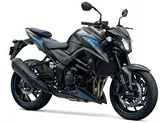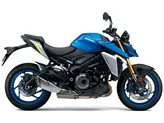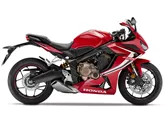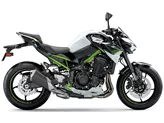Suzuki GSX-S750 2017 vs. Kawasaki ER-6n 2013

Suzuki GSX-S750 2017

Kawasaki ER-6n 2013
Overview - Suzuki GSX-S750 2017 vs Kawasaki ER-6n 2013
The Suzuki GSX-S750 2017 and the Kawasaki ER-6n 2013 are both naked bikes with similar engine types and cooling systems. However, there are several key differences between the two models.
In terms of engine power, the Suzuki GSX-S750 2017 has a significant advantage with 114 HP compared to the Kawasaki ER-6n 2013's 72 HP. This means that the Suzuki model offers a more powerful and potentially faster riding experience.
The torque of the Suzuki GSX-S750 2017 is also higher at 81 Nm compared to the Kawasaki ER-6n 2013's 64 Nm. This means that the Suzuki model will have better acceleration and pulling power.
Another difference is the number of cylinders. The Suzuki GSX-S750 2017 has 4 cylinders, while the Kawasaki ER-6n 2013 has only 2 cylinders. More cylinders generally result in smoother power delivery and better overall performance.

Suzuki GSX-S750 2017
In terms of suspension, both models feature a monoshock rear shock absorber. This type of suspension offers good stability and control, providing a comfortable and smooth ride.
The chassis of the Suzuki GSX-S750 2017 is made of aluminum, while the Kawasaki ER-6n 2013 has a steel frame. Aluminum frames are generally lighter and offer better handling and maneuverability.
Both models have double disk brakes at the front with double piston calipers. This ensures strong and reliable braking performance for both bikes.
In terms of dimensions and weights, the Suzuki GSX-S750 2017 has a slightly wider front tire at 120 mm compared to the Kawasaki ER-6n 2013's 120 mm front tire. The rear tire width of the Suzuki model is also wider at 180 mm compared to the Kawasaki model's 160 mm rear tire. The wheelbase of the Suzuki GSX-S750 2017 is longer at 1455 mm compared to the Kawasaki ER-6n 2013's 1410 mm wheelbase. The seat height of the Suzuki model is also higher at 820 mm compared to the Kawasaki model's 805 mm seat height. In terms of weight, the Suzuki GSX-S750 2017 is slightly heavier with a kerb weight of 213 kg compared to the Kawasaki ER-6n 2013's 204 kg kerb weight.

Kawasaki ER-6n 2013
In terms of strengths, the Suzuki GSX-S750 2017 has a GSX-R 750 engine with a strong character, powerful and well-controlled brakes, a harmonious design, an affordable price, a sharp sound, and great lean angle clearance. On the other hand, the Kawasaki ER-6n 2013 is praised for its solid handling and high-quality level.
However, the Suzuki GSX-S750 2017 does have some weaknesses. Some riders may find the knee angle to be acute, which could be uncomfortable for longer rides. Additionally, the tachometer may be difficult to read for some riders.
The Kawasaki ER-6n 2013 has a weakness in its brakes, which are considered to be weak compared to the Suzuki GSX-S750 2017.
In conclusion, the Suzuki GSX-S750 2017 offers more power, better torque, and a slightly more advanced design compared to the Kawasaki ER-6n 2013. However, the Kawasaki model is praised for its solid handling and high-quality level. Ultimately, the choice between the two models will depend on the rider's preferences and priorities.
Technical Specifications Suzuki GSX-S750 2017 compared to Kawasaki ER-6n 2013
Pros and Cons in comparison
Pros and Cons in comparison
Suzuki GSX-S750 2017

More power, more performance, more sound. Suzuki also proves all the pessimists regarding the EURO4 standard wrong and delivers the GSX-S 750, a successor to the GSR 750 that has been further developed in every respect and can be a bit more serious, but doesn't have to be. To ensure that aha moments don't become oje moments, ABS and a three-stage traction control that can be switched off provide a safety cushion. With S21 tyres from Bridgestone, the GSX-S is super-sporty, allowing you to take advantage of the generous lean angle clearance. Only the acute knee angle could be a disadvantage on longer tours.
Kawasaki ER-6n 2013

The engine is hearty and a lot of fun, plus the ER shines with a Japanese meticulous finish and a fighting price.
Price Comparison Avarage Market Price Suzuki GSX-S750 vs Kawasaki ER-6n
There are a few key differences between a Suzuki GSX-S750 2017 and a Kawasaki ER-6n 2013. There are the same number of bikes of both models available on the 1000PS.de marketplace, specifically 14. It takes less time to sell a Kawasaki ER-6n with 42 days compared to 84 days for the Suzuki GSX-S750. Since model year 2017 1000PS.de editors have written 14 reviews for the Suzuki GSX-S750 and 16 reviews for the Kawasaki ER-6n since model year 2006. The first review for the Suzuki GSX-S750 was published on 10/4/2016 and now has more than 50,800 views. This compares to more than 11,200 views for the first review on Kawasaki ER-6n published on 6/29/2005.

















